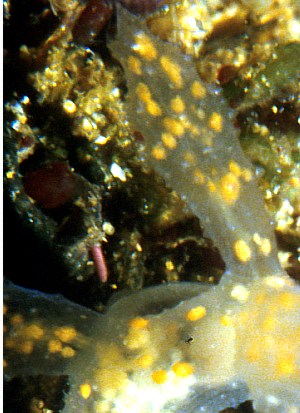
Melibe maugeana
Burn, 1960
Order: NUDIBRANCHIA
Suborder: DENDRONOTINA
Family: Tethydidae
DISTRIBUTION
Known from South Australia, Victoria and Tasmania in southern Australia
PHOTO
attached to some kelp floating in Port Phillip Bay, Victoria, Australia. 30 November 2002. Photo: Christine Walsh
This species has the typical body shape of Melibe with a large oral hood and a few large cerata down each side of the body. The oral hood has a single row of relatively long papillae along the edge, and the cerata are long and cylindrical or fusiform in shape. The body is translucent, almost transparent, in colour, with scattered opaque white spots at the tip of small pointed papillae on both the body and the cerata. Burn (1957) describes 'general body colour transparent pale yellow or orange, longitudinally lined with bright yellow streaks, everywhere flecked with red dashes. Apices of first pair of cerata usually red'. I can find no yellow colouration in the attached photo, but I must assume this is the same species. I know of no other illustrations of this species other than the original black & white drawing. See photos of probable juvenile from Tasmania in attached message
Originally named Melibe pellucida, Burn later discovered this name had been used by Bergh (1904), and renamed it M. maugeana (Burn, 1960).
References:
• Burn, R.F. (1957) On some Opisthobranchia from Victoria. Journal of the Malacological Society of Australia, 1: 11-29, Pls 1-3.
• Burn, R.F. (1960) New names for two Victorian opisthobranch molluscs. Journal of the Malacological Society of Australia, 1(4): 70.
Rudman, W.B., 2002 (December 2) Melibe maugeana Burn, 1960. [In] Sea Slug Forum. Australian Museum, Sydney. Available from http://www.seaslugforum.net/find/melimaug
Related messages
More photos of Melibe maugeana
May 25, 2006
From: Bill Rudman


To accompany Sabine Dittmann's message [#16693] about Melibe maugeana here are a few close-ups to show some features of the live animal. Species of Melibe lack a radula, and because their bodies are so thin they can lose much of their shape on preservation. They can also autotomise their cerata on preservation - or in the normal course of their life. Because of this, distinguishing species can be quite difficult. I suspect when we know more about this group, they should be identifiable from the shape and colour of the living animal. However, at present we don't have a good idea on variability within populations, so it is not yet possible to make good judgements on what constitutes infraspecific variation and what constitutes interspecific variation. Because of this a few more photos may be useful in the future.
Locality: Flinders Island, 6 m, [west coast of Eyre Peninsula], South Australia, Great Australian Bight, 21 June 2006, subtidal Posidonia seagrass bed. Length: 1 cm. Photographer: Sabine Dittmann.
Rudman, W.B., 2006 (May 25) More photos of Melibe maugeana. [Message in] Sea Slug Forum. Australian Museum, Sydney. Available from http://www.seaslugforum.net/find/16701
The upper two photos show dorsal and ventral views of the oral veil or oral hood, which is so effective as a net in which to catch small crustacea. In all the photos you will see traces of a fine translucent white or brownish network throughout the transparent body wall. This is sometimes described as a network of fibres or digestive gland ducts but it seems to be a mixture of muscle fibres, fine ducts of the digestive gland, and nerve fibres. If you look at the oral veil in the uppermost photo you can see 'fibres' radiating out from each rhinophore to the edge of the oral hood. These could be described as multiplex cables with nerve fibres to communicate with the sensory tentacles around the edge of the hood and muscle fibres to contract the hood when catching prey. The brown colouration shows that there is also digestive gland contents present as well. It is possible that like some other species of Melibe, this species contains symbiotic zooxanthellae - but I must emphasise that that is just a guess on my part.
The second photo shows the oral hood from underneeth - a crustacean-eye view. Once the sensory tentacles make contact with a food-like item, the edge of the hood is contracted -as though it has a draw-string - and the potential prey trapped.
The bottom photo is of one rhinophore. In Melibe, the rhinophores are relatively small, perhaps a reflection of the diminished importance of chemoreception in Melibe in feeding, and the much greater importance of the sensory tentacles around the edge of the oral hood, .
Best wishes,
Bill Rudman
Melibe maugeana from South Australia
May 25, 2006
From: Sabine Dittmann
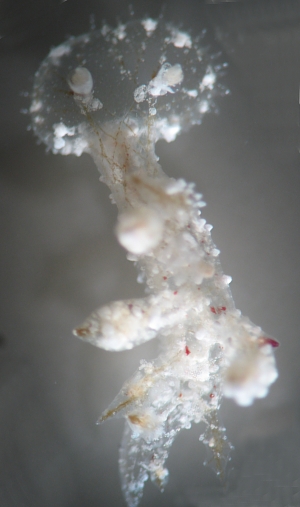
Hi Bill,
We just spoke on the phone. Here are some pictures of the crazy creature which I collected during an expedition to the Investigator Island Group. At present it is very happy in an aquarium and busy trying to catch Rotifers. Not the preferred food size (too small), but it seems to keep it busy. I've taken some nice video footage of it feeding etc which provide some more acurate insights.
Locality: Flinders Island, 6 m, [west coast of Eyre Peninsula], South Australia, Great Australian Bight, 21 June 2006, subtidal Posidonia seagrass bed. Length: 1 cm. Photographer: Sabine Dittmann.
Hope to hear back soon.
Cheers
Sabine
sabine.dittmann@flinders.edu.au

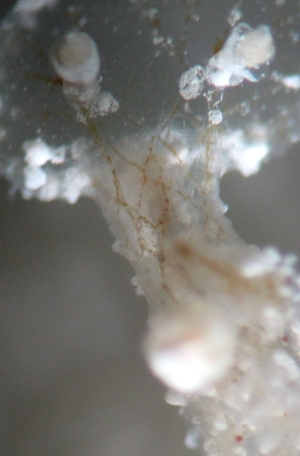

Dear Sabine,
This is quite an exciting find. It is a perfect match to Bob Burn's description of Melibe maugeana from Victoria. Checking through the literature I suspect this is the first time it has been reported since its original description. There are a few animals on the Forum which I have tentatively identified as M maugeana, but now I see your animal with the red marks, which were specifically mentioned by Bob Burn, I suspect the others [#8562, #8560, #8680 ], are not that species. If so, I suspect we may have at least one more unnamed species in southern Australia.
I have added a few extra close-up photos in a separate message in case they are useful for comparative purposes [message #16701 ]
Best wishes,
Bill Rudman
Photos of Melibe maugeana from Melbourne
December 18, 2002
From: Harry Thorman

Hi Bill.
Sorry for the delay in replying to your comments Sadly our Melibe sp. did not survive the photo shoot and died the following day despite the tender loving care we gave to our super attraction. Christine Walsh, one of our volunteer helpers did get significantly better pictures than mine and I have attached a selection of her pictures. The slug was a real superhero and attraced much attention.
In memorium of a unique animal!
Harry Thorman
Harry.Thorman@nre.vic.gov.au
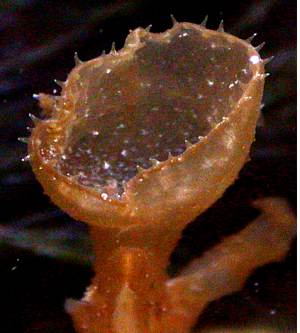
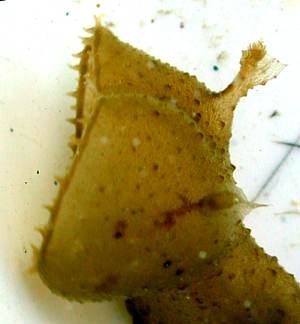
Thanks Harry & Christine,
These photos are great. They show the red 'flecking' mentioned by Burn in his description, although they don't show the yellow marks. I suspect the transparent animal from Tasmania, with the yellow subepidermal spherules, is a juvenile of this. I think the whitish spherules in your animal are probably the same 'glands'. These photos also show the single row of relatively long papillae around the edge of the oral hood.
Best wishes,
Bill Rudman
Melibe? from Port Philip Bay, Victoria
December 4, 2002
From: H. Thorman & A. McLaughlin
Hi.
We have a weird little fellow that we are having trouble tracking. It is a 'slug' greenish-brown in colour, about 4cm long with appendages rather like a sea hare. We caught it attached to some kelp floating in Port Phillip Bay, Victoria [Australia] last Friday (30 November 2002).
Its most peculiar feature is a balloon like basket mouth projection that it opens and closes as if casting a net to catch plankton. Around the 'net' are tiny hair like projections.
Harry Thorman and Anne McLaughlin
harry.thorman@nre.vic.gov.au
Dear Harry and Anne,
Its a bit hard too identify marine animals without a photo but your description of 'a balloon like basket mouth projection that it opens and closes as if casting a net to catch plankton' is a pretty good description of the oral hood of a species of Melibe. I suspect your animal is Melibe maugeana a species which is only known from South Australia, Victoria and Tasmania in southern Australia. Have a look at some of the other species of Melibe on the Forum:
Melibe engeli
Melibe leonina
Melibe mirifica
Melibe viridis
Tethys fimbria
Let me know if I've solved your problem, and if you have any photos of it they would be a useful addition to our knowledge
Best wishes,
Bill Rudman
Melibe maugeana from nthn Tasmania
December 4, 2002
From: Bill Rudman
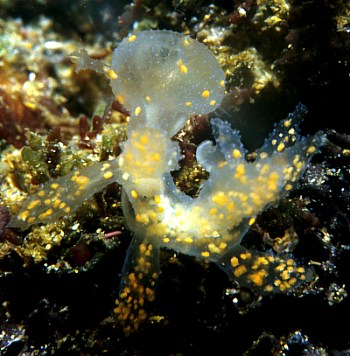
To accompany Harry & Anne's message about a possible Melibe from Port Philip Bay, Victoria, here is a record of Melibe maugeana from northern Tasmania. As far as I know this is the first published colour photo of this species.
Horseshoe Reef, Devonport, Tasmania, 12m. 23 February 1985. Photo: G. Close.
Best wishes,
Bill Rudman

